The Pentatonic's Inner Pattern
If you are primarily a pentatonic player, there is a hidden pattern within the familiar pentatonic scale, that is the key to opening up the whole fretboard, giving you virtually complete freedom on any part of the neck.
There are five "box shapes" for the pentatonic scale, which you should know. Diagrams of these five shapes can be found by clicking here.
Have a look at box shape number one of the pentatonic scale below (this is the shape most people know and use most).
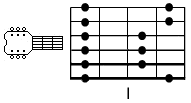
Ignoring for a moment the lowest string, look at the A, D, G, B and high E strings in the diagram. First look at the A string. Notice that the distance between the two dots on that string is a wholetone. Now look at the distance between the two dots on the B string, this is a wholetone plus a semi tone. In order to make working with these distances easier, lets use shorthand names for them. We'll call the wholetone distance a "little shape" and we'll call the wholetone plus a semitone distance a "big shape". Silly sounding names, maybe, but its easier to work with these short hand terms.
Looking again at the diagram starting on the A string and going up the strings (in blue):
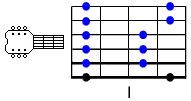
Notice that there are 3 "little shapes" followed by 2 "big shapes". This sequence, 3 little, 2 big; is the key to unlocking the neck.
Let's see why.
Look at the following diagram of the third box shape of the pentatonic scale. If you are unfamiliar with the five pentatonic box shapes here's another chance to click here for a full set of diagrams.
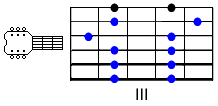
Notice that starting on the low E string and going up, we have the same sequence: 3 little, 2 big.
This sequence is contained in all five of the pentatonic box shapes. In some of them however, it gets broken up as you reach the top string before the end of the inner pattern we've been looking at. It can be a little tricky to grasp at first, but once you get it, this inner pattern is the key to everything if you're a pentatonic player.
The inner pattern: 3 little, 2 big, as you can see covers 5 strings. Once you've gone through the 3 little shapes and the 2 big shapes, if you have more strings left as in box three of the pentatonic below, you'll start the pattern again:
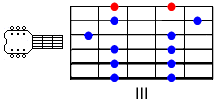
As you can see in the shape above, on the high E string the pattern starts again with the first of the 3 little shapes (in red).
Think of the inner pattern as a continuous loop ie: 3 little, 2 big, 3 little, 2 big, 3 little, 2 big, etc....
In each of the five pentatonic box shapes, you are starting somewhere in this inner pattern. Keep in mind though, that you might start at any point in the pattern. Where ever you start though, it will always follow on as it should.
Here's an example: take the second pentatonic box shape.
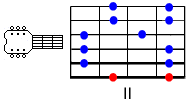
Notice that it starts on the last of the 3 little shapes. The first two are "off the neck" as it were. So although at first glance it might seem as though the pattern has changed, in fact it hasn't. Its just that in this position, we're starting somewhere in the middle of the inner pattern.
Because we've played the last of the little shapes, we naturally should go on to the 2 big shapes, and as you can see from the diagram above, that's exactly what happens. Once we've completed the pattern by playing the 2 big shapes, we continue by starting the pattern again with the 3 little shapes - as you can see in this case, on the top three strings.
OK, now hopefully you understand and can see the inner pattern in any of the five pentatonic box shapes. If you're not sure, study the five pentatonic box shapes (click here if you need to see them) and the inner pattern - 3 little, 2 big - until you can easily identify where you are in the inner pattern in any of the five box shapes.
Now its time to see why this inner pattern is so useful.
Look at the diagram of the minor pentatonic, box shape one below:
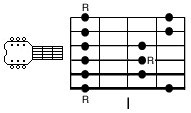
Notice where the roots are. The root appears in two places in the inner pattern.
- 1) In the middle of the little shapes (under your 3rd finger).
- 2) In the second of the big shapes (under your 1st finger)
Now here's the significant part: The roots will always be in this part of the inner pattern no matter what box shape you are in.
This means many important things.
For example:
- 1) Once you see where a riff is in the inner pattern in one pentatonic box shape, you'll be able to see how to play the same riff, using the same notes, in any other box shape in any other part of the neck.
- 2) Its easy to learn where the intervals are in the inner pattern. Once you know this, you can see the intervals anywhere on the neck. If you don't understand the importance of intervals click here for an article on this subject. click here for diagrams of the pentatonic box shapes which include the intervals.
- 3) Once you've learned the notes on the neck (which we highly recommend), you can simply find the root note of the chord you are playing over, on any string, on any fret on the neck, apply the appropriate place for the root within the inner pattern - and there you are, instant scale shape from anyplace on the fretboard. This means you are free to jump to any part of the neck at any time. click here for an article about a quick way to learn the notes on the neck.
- 4) If you know how to play modes within the pentatonic shapes, the inner pattern will allow you to play modes all over the fretboard, starting on any string. For an article on playing modes from the pentatonic shapes click here.
Are you're thinking something like; "well, this all seems like a lot to learn, I'm not sure if I want to spend the time"?
Think about this: What's your alternative? Being stuck in the one or two positions you know well. Trying to use "intuition" to find the right notes in other parts of the neck. Having lots of scale shapes and not knowing what to do with them. Being afraid to jump up the neck because you might get lost. Getting stuck in a rut because you always have to start in the same part of the same scale shape.
It takes a bit of time and work to get used to thinking in terms of the inner pattern, but its more than worth it. With a little work, you'll see the inner pattern like the back of your hand and this will open up the whole fretboard for you.
Mark Wingfield



